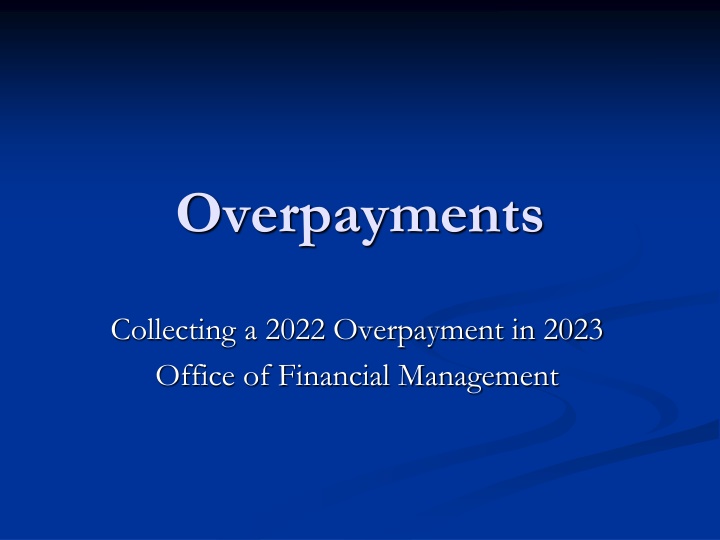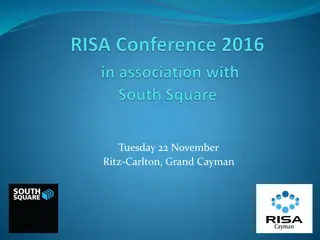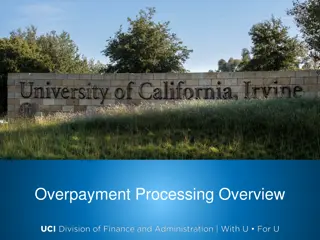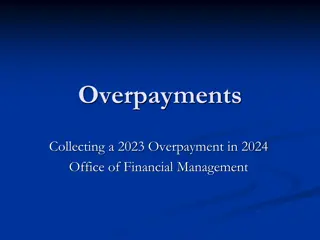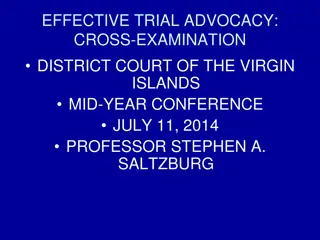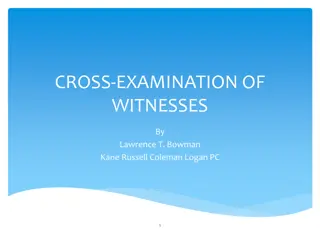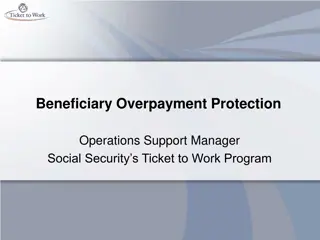Managing Overpayments and Changing Collection Procedures for Cross-Year Overpayments
Overpayments collecting in one year but repaid in another can lead to tax reporting issues. To prevent discrepancies, it is essential to switch from gross to net overpayment collection. This ensures accurate tax withholdings and reporting for both the employee and the employer. The process involves adjusting payroll systems and payment schedules to align with IRS and SSA guidelines, ultimately improving financial management practices.
Download Presentation

Please find below an Image/Link to download the presentation.
The content on the website is provided AS IS for your information and personal use only. It may not be sold, licensed, or shared on other websites without obtaining consent from the author.If you encounter any issues during the download, it is possible that the publisher has removed the file from their server.
You are allowed to download the files provided on this website for personal or commercial use, subject to the condition that they are used lawfully. All files are the property of their respective owners.
The content on the website is provided AS IS for your information and personal use only. It may not be sold, licensed, or shared on other websites without obtaining consent from the author.
E N D
Presentation Transcript
Overpayments Collecting a 2022 Overpayment in 2023 Office of Financial Management
Why change? Why do we have to change to a net overpayment instead of a gross when an overpayment crosses the calendar year? The IRS says that: Overpayments for prior years are not reductions of current year amounts subject to FIT withholding. Overpayments for prior years should not cause a reduction of FIT withholding tax paid this year. Any FIT tax overpayment the employee has made should be recovered by the employee on his next tax return, as a deduction from income. If the overpayment is never repaid, it is considered taxable wages. The SSA says that: Medicare and Social Security overpayments should be reported to the Social Security Administration as soon as they are repaid, but for the correct tax year.
The Problem: If we keep collecting the gross overpayment in the new year, we break most of the above rules Gross subject to FIT will be understated. FIT withheld will be incorrect. Reductions to Social Security and Medicare subject amounts are reported in the wrong year. Social Security and Medicare is reported in the wrong year.
Example: Personnel No. 12345432 SAMPLE JOHN Q - USA Seq. number 00195 - accounted on 11/16/2022 - current result For-Period 22.2022 (11/01/2022 - 11/15/2022) In-Period 22.2022 (Fin.: 11/15/2022) * /R00 Regular Ra 21.08 96.00 2,023.91 * 2143 LTD 01 B 04 38.04- * 2260 N2 PSERS 2 01 B 03 135.23- * 2360 N2 ER PSER B 03 175.98 * 2538 Reg BlueSh 01 B 02 69.50- * 2550 Health - E B 02 353.50 * 2575 Health - P 01 B 02 423.00 * 3223 RepayPlan * 3224 RePay bala * 3225 RePay Tota * 9182 P0/T0 Base 2,058.23 * 9188 PSERS 2 Ba 50.00- 300.00 750.00- 2,058.23
Current Situation: Overpayment Details: As of 11/23/2022, how much has the employee paid? $750 repaid as of this pay date (WT 3225) + 300 balance remaining (WT 3224) 1,050 Total Gross overpayment We originally had a gross overpayment of $1,050. The employee agreed to pay it back $50 per pay period. The employee has paid back $750 EE will make two more payments on Dec. 9 and Dec. 23, adding another $100. $750 + $100 = $850 repaid as of the end of 2022 $1,050 - $850 = $200 gross to be paid in 2023
Stop the Old Collection Turn off the 2022 gross deduction in HRMS, before 12/23 payroll exits. IT 0014 Recurring Payments/Deductions Use the Pencil to change the end date of WT 3223 to 12/15/2022 Remember, 12/1 to 12/15 is paid on 12/23 We don t want to take any more gross deductions in 2023. IT 0015 Additional Payments: Use the Pencil Change the amount of WT 3224 to $850 We will only collect $850 in 2021 If we look later, we ll be able to see easily that $850 will be collected in 2022 If we have another overpayment later, the leftover balance could cause problems with the new overpayment.
Calculate the New Collection How much are we going to collect from the employee in 2023? $ 200.00 gross. - 12.40 (6.2% Social Security OASI) - 2.90 (1.45% Medicare HI) $ 184.70 Net pay recovered in 2023.
Calculate the New Collection How many payments were left? $200.00 / $50.00 = 4 payments So, $184.70 / 4 payments = $46.18 $46.18 x 4 = 184.72, so take $0.02 off of the final payment.
Start the New Collection Key 3101/3111 combination $46.18 payment (3101) for 3 pay periods (eff. 12.16.2022 01.31.2023) $138.54 balance (3111) of 3 payments (eff. 12.16.2022) And since the total balance due is not divisible by 4 you will need to key another 3101/3111 $46.16 payment (3101) for 1 pay period (eff. 02.01.2023 02.15.2023) $46.16 balance (3111) of the final payment (eff. 02.01.2023) This will equal the total amount due of $184.70 and employee is only paying back the gross, less SS and Medicare!
Employer Taxes What about the employer taxes? When we pay back gross in the same year, taxes are automatically adjusted, including EE and ER share. When we pay back net in the next year, taxes aren t adjusted at all! We want to get the agency s money back as soon as possible, so recover taxes immediately: Agency = 6.2%, SS $12.40, 1.45% Med $2.90 Write a JV to reverse the Social Security and Medicare expenditure on the agency side.
Tax Recovery JV Account 035, TC 025 (1324V/7140) DR $15.30 Operating, TC 670 (7140/6510) SubObject BA CR $12.40 Operating, TC 670 (7140/6510) SubObject BH CR $ 2.90 IFT JV: Don t send to OST!!! Basically, we re carrying a receivable in 035 until we get the tax refund.
Employee Repayment As the employee pays back the money, it will accrue as a credit in Account 035, GL 1324 No additional JV is necessary for the net pay collection.
Employees Done Paying After the employee is done paying back, we have $15.30 + $15.30 = $30.60 left as a receivable in Account 035, GL 1324. This is the money we get from the Feds. We have to file a tax return to get it. We shouldn t file frequent amended returns if we can avoid it. We should file the tax return once the employee has repaid in full, or at reasonably infrequent intervals (for instance, annually.)
YTD Corrections Once the employee has paid us back in 2023: Make adjustments to: Employee OASI/Med Taxable wages and Tax Employer OASI/Med Taxable wages and Tax Per the IRS, we don t change 2023 FIT at all. Employee may claim as a deduction in 2024 (for 2023) tax return. How do I make these adjustments? Complete adjustment worksheet Use as source document for PU19 adjustments Contact the Solutions Center for procedures if you need help!
Agency Adjustment Worksheet Use OFM s Agency Adjustment Worksheet available online at https://support.hrms.wa.gov/sites/default/files/public/resources/yearE nd/AgencyYTDManualUpdates%20for%20web%20Aug%202012.xls Note Tax Tax Group (TxGr) Person nel Area Authority (FED, WA, etc) Taxable or Value Effective Date Tax PERNR 12345432 9898 FED 12/23/2022 0003 -200.00 -12.40 EE Social Sec. 12345432 9898 FED 12/23/2022 0004 -200.00 -12.40 ER Social Sec. 12345432 9898 FED 12/23/2022 0005 -200.00 -2.90 EE Medicare 12345432 9898 FED 12/23/2022 0006 -200.00 -2.90 ER Medicare
Refund This results in $30.60 due back from IRS for 4th quarter. File 941 (or 941-X if we ve already filed.) File W-2c, provide employee with copy. (remember, don t change Box 1 or Box 2!) When we get the check back from the U.S. Treasury: Make a deposit: AFRS Form A-8 Account 035: TC 090 (7110/1324V) $30.60 1324 should be clear with respect to this overpayment. If there was interest paid by IRS, deposit it to revenue source 0499 in the operating account.
Retirement/Dues/Misc. What about Retirement, union dues, etc.? Any other changes that must be made should be done manually, with retirement adjustment codes, union adjustment codes, etc. In the subsequent year, employee will always pay back gross, less Social security and Medicare. Any other money owed to the employee should be paid back with adjustment codes. If retirement, make adjustments to ERA based on the overpayment dates, not the repayment dates. This keeps our current year taxable amounts correct (some of those deductions are pretax).
Retirement/Dues/Misc. For more information on wage repayments for previous years, see IRS Publication 15 Wage Repayments
